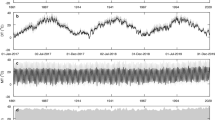Abstract
The objective of the study is to detect geographical and temporal variations of near surface air temperatures over Minnesota and Wisconsin, USA derived from the North American Regional Reanalysis (NARR) dataset. In addition, the study serves to assess the usefulness of NARR temperature data to analyze regional and local temperature variations. Particular emphasis was placed on the analyses on the temperature-modifying effects of the Great Lakes and large urban environments. We analyzed annual mean, daily maximum and minimum, and January minimum and July maximum temperatures for the period 1979–2006 by using methods such as ordinary kriging, principal component analysis, and the Mann–Kendall test. On a regional scale, we found significant effects of the latitude and the Great Lakes on the spatial variability of the data. Furthermore, we found clearly identifiable effects of large urban areas in the study region (Minneapolis—Saint Paul and Milwaukee), which are more evident in the principal component scores than in the temperature data themselves. While we failed to detect significant July maximum temperature trends, we detected significantly increasing trends in January minimum and mean annual temperature datasets in the eastern part of the region. Overall, the present study has demonstrated the potential of using NARR data for urban climate research.








Similar content being viewed by others
References
Andronache C (2009) Principal component analysis of sea surface temperature in the North Atlantic Ocean. Int J Mod Phys C20:1789–1802
Angel JR (2004) Temperature variability in Illinois: 1895–2002. Trans Ill State Acad Sci 97:103–116
Arnfield AJ (2003) Two decades of urban climate research: a review of turbulence, exchanges of energy and water, and the urban heat island. Int J Climatol 23:1–26
Austin JA, Colman SM (2007) Lake Superior summer water temperatures are increasing more rapidly than regional air temperatures: a positive ice-albedo feedback. Geophys Res Lett 34:L06604. doi:10.1029/2006GL029021
Becker S, Gemmer M, Jiang T (2006) Spatiotemporal analysis of precipitation trends in the Yangtze River catchment. Stoch Env Res Risk Assess 20:435–444
Chang K (2012) Introduction to geographic information systems. McGraw-Hill, New York
Choi W, Kim SJ, Rasmussen PF, Moore A (2009) Use of the North American Regional Reanalysis for hydrological modelling in Manitoba. Can Water Resour J 34:17–36
Cueto ORG, Martinez AT, Morales GB (2009) Urbanization effects upon the air temperature in Mexicali, B.C., Mexico. Atmosfera 22:349–365
Kalnay E, Cai M (2003) Impact of urbanization and land-use change on climate. Nature 423:528–531
Kalnay E, Cai M, Li H, Tobin J (2006) Estimation of the impact of land-surface forcings on temperature trends in eastern United States. J Geophys Res-Atmospheres 111:D06106. doi:10.1029/2005JD006555
Kistler R, Kalnay E, Collins W, Saha S, White G, Woollen J, Chelliah M, Ebisuzaki W, Kanamitsu M, Kousky V, van den Dool H, Jenne R, Fiorino M (2001) The NCEP-NCAR 50-year reanalysis: monthly means CD-ROM and documentation. Bull Am Meteorol Soc 82:247–267
Manly BFJ (2009) Statistics for environmental science and management. CRC, Boca Raton
Mesinger F, DiMego G, Kalnay E, Mitchell K, Shafran PC, Ebisuzaki W, Jović D, Woollen J, Rogers E, Berbery EH, Ek MB, Fan Y, Grumbine R, Higgins W, Li H, Lin Y, Manikin G, Parrish D, Shi W (2006) North American Regional Reanalysis. Bull Am Meteorol Soc 87:343–360
Nuñez MN, Ciapessoni HH, Rolla A, Kalnay E, Cai M (2008) Impact of land use and precipitation changes on surface temperature trends in Argentina. J Geophys Res-Atmospheres 113:D06111. doi:10.1029/2007JD008638
Oke TR (1978) Boundary layer climates. Methuen, London
Oke TR, Zeuner G, Jauregui E (1992) The surface energy balance in Mexico City. Atmospheric Env Part B 26:433–444
Peterson TC (2003) Assessment of urban versus rural in situ surface temperatures in the contiguous United States: no difference found. J Clim 16:2941–2959
Runnalls KE, Oke TR (2000) Dynamics and controls of the near-surface heat island of Vancouver, British Columbia. Phys Geogr 21:283–304
Santos JF, Pulido-Calvo I, Portela MM (2010) Spatial and temporal variability of droughts in Portugal. Water Resour Res 46:W03503. doi:10.1029/2009WR008071
Schlünzen KH, Hoffmann P, Rosenhagen G, Riecke W (2010) Long-term changes and regional differences in temperature and precipitation in the metropolitan area of Hamburg. Int J Climatol 30:1121–1136
Sneyers R, Vandiepenbeeck M, Vanlierde R (1992) Principal component analysis of air temperature in Belgium. Theor Appl Climatol 45:61–63
Stone B (2007) Urban and rural temperature trends in proximity to large US cities: 1951–2000. Int J Climatol 27:1801–1807
Toreti A, Fioravanti G, Perconti W, Desiato F (2009) Annual and seasonal precipitation over Italy from 1961 to 2006. Int J Climatol 29:1976–1987
United Nations Department of Economic and Social Affairs Population Division (2004) World urbanization prospects: the 2003 revision. United Nations, New York
Wilby RL (2008) Constructing climate change scenarios of urban heat island intensity and air quality. Env Plan B 35:902–919
Woo M, Thorne R (2006) Snowmelt contribution to discharge from a large mountainous catchment in subarctic Canada. Hydrol Process 20:2129–2139
Zhang Q, Jiang T, Gemmer M, Becker S (2005) Precipitation, temperature and runoff analysis from 1950 to 2002 in the Yangtze Basin, China. Hydrol Sci J 50:65–80
Zhang Q, Xu CY, Zhang Z, Chen YD, Liu CL (2009) Spatial and temporal variability of precipitation over China, 1951–2005. Theor Appl Climatol 95:53–68
Acknowledgments
Financial support for the research presented here came from the Graduate School Research Committee Award and the Office of Undergraduate Research’s Salary for Undergraduate Research Fellows at the University of Wisconsin—Milwaukee. The authors appreciate the constructive feedback from the anonymous reviewers and mapping assistance from Mr. Deng at the University of Wisconsin—Milwaukee.
Author information
Authors and Affiliations
Corresponding author
Rights and permissions
About this article
Cite this article
Choi, W., Keuser, A. & Becker, S. Identification of mid-latitudinal regional and urban temperature variabilities based on regional reanalysis data. Theor Appl Climatol 107, 87–98 (2012). https://doi.org/10.1007/s00704-011-0466-0
Received:
Accepted:
Published:
Issue Date:
DOI: https://doi.org/10.1007/s00704-011-0466-0




